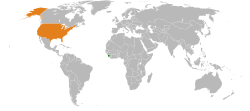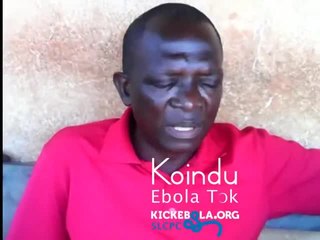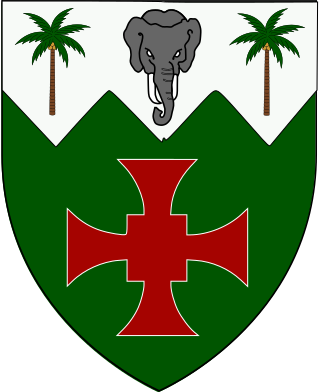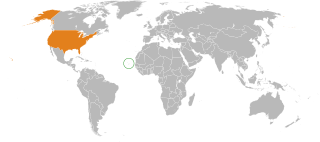 | |
Sierra Leone | United States |
|---|---|
Sierra Leone – United States relations are bilateral relations between Sierra Leone and the United States.
 | |
Sierra Leone | United States |
|---|---|
Sierra Leone – United States relations are bilateral relations between Sierra Leone and the United States.
United States-Sierra Leone relations date back at least to 1748 when the London firm of Grant, Sargent, and Oswald rebuilt the abandoned trading fort at Bunce Island and focused on supplying slaves to Charleston, South Carolina where local rice planters paid a premium for slaves from Sierra Leone and the neighboring areas in West Africa's Rice Coast because of their specialized knowledge and skill in rice cultivation. [1] [2]
Richard Oswald was the principal partner in the firm Grant, Sargent, and Oswald. Henry Laurens had established a close personal and business relationship with Oswald when he was sent to Great Britain to learn business with the Oswald family trading firm. Every year Oswald's agents at Bunce island dispatched to Charleston several ships carrying 250 to 350 slaves. Laurens advertised the slaves and sold them at auction to local rice planters, earning a ten percent commission. He used his earnings to purchase Carolina rice which he sent to Oswald in London, often in the same ship that brought the slaves from Bunce Island. The slave and rice trading connection between Oswald and Laurens—between Sierra Leone and South Carolina—made both men wealthy, propelled both into politics, and eventually affected the course of American history. Oswald advised Prime Minister Lord North on trade regulations and the best way to respond to the Rebellion in America". Meanwhile, Laurens served as President of the Second Continental Congress and was later dispatched to The Hague to negotiate a treaty for Dutch support. The British Navy captured Laurens and he was charged with high treason and imprisoned in the Tower of London until Oswald posted bail for his American business partner. [1] [2]
Jealous of the commercial success of Bunce Island, in 1779 the French took the opportunity of their alliance with the American revolutionaries to attack and destroy the slave trading fort. Thus, a battle of the American Revolution was actually fought in Sierra Leone. [1]
In 1782 the Continental Congress appointed Laurens as one of the four American Peace Commissioners (along with John Adams, Benjamin Franklin, and John Jay) who would negotiate United States independence and the formal end to the war under the Treaty of Paris. Prime Minister Lord Shelburne appointed Oswald to lead the British plenipotentiaries. Thus, the independence of the United States was negotiated, at least in part, between British and American partners in the trade of slaves from Sierra Leone to South Carolina. [1] [2]
In 1858 the United States formally opened a Consulate in Freetown headed by Commercial Agent John E. Taylor who had previously been informally appointed as acting consul as early as 1853 by Commodore Issac Mayo of the USS Constitution. The Consulate was charged with protecting American citizens and promoting U.S. commercial interests, with the assistance—if necessary—of U.S. naval vessels of the Africa Squadron. Freetown became responsible for all of West Africa outside Liberia as posts at Goree-Dakar, Bathurst, St. Louis, and Bissau were closed. When the triple city of Dakar (with Goree and Rufisque) became the headquarters of the Government General of French West Africa, responsibility for West Africa was moved there and the Freetown consulate was closed on March 30, 1915. [3] [4] [5]
In 1862 Timothy R. Hibbard and Charles V. Dyer were appointed Arbitrator and Judge, respectively, of the Anglo-American Mixed Court for the Suppression of the Slave Trade in Sierra Leone at Freetown established by the Lyons–Seward Treaty of 1862 to adjudicate allegations of illegal slave trading and condemn slaving ships. Because the Atlantic slave trade declined in the 1860s, the Anglo-American courts were never called upon to decide a case. Hibbard and Dyer however took up a broader intervention proposing a treaty system with African nations that in the cause of suppressing the slave trade, that would expand American trade in West Africa, introduce American military protection to the interior of the continent, and “civilize” the people there through agricultural reform. [3] [6]

In 1959, the United States reopened the consulate in Freetown and elevated it to embassy status when Sierra Leone became independent in 1961. U.S.-Sierra Leone relations today are cordial, with ethnic ties between groups in the two countries receiving increasing historical interest. Many thousands of Sierra Leoneans reside in the United States. The United States recognized Sierra Leone's independence from the United Kingdom on April 27, 1961. [7] Diplomatic relations were initiated on the same day, with the elevation of the existing American Consulate General in Freetown to Embassy status. Herbert Reiner Jr. served as the Chargé d'Affaires ad interim. [7]
The U.S. engagement in Sierra Leone has been intertwined with efforts to foster peace, particularly during the Sierra Leone Civil War from 1991 to 2002. The United States has been actively involved in international endeavors to halt the civil war and prevent the illicit trade of diamonds originating from Sierra Leone. [7]
The outbreak of the Ebola epidemic in May 2014 overwhelmed the country's medical infrastructure until containment was declared in November 2015. The Sierra Leonean government initiated a comprehensive recovery plan, with considerable international support, including from the United States. [8] [9] In 2023, the U.S. announced a $450,000 grant to preserve an old Fourah Bay College building. [10]
In fiscal year 2006, total U.S. bilateral aid to Sierra Leone in all categories was $29.538 million. U.S. assistance focused on the consolidation of peace, democracy and human rights, health education, particularly combating HIV/AIDS, and human resources development.
As of September 2023, the United States Ambassador to Sierra Leone is Bryan David Hunt. Sierra Leone's Ambassador to the United States is H. E. Bockari Kortu Stevens and the Sierra Leone embassy is located in Washington. [11]

Sierra Leone, officially the Republic of Sierra Leone, is a country on the southwest coast of West Africa. It shares its southeastern border with Liberia and is bordered by Guinea to the north. With a land area of 71,740 km2 (27,699 sq mi), Sierra Leone has a tropical climate and with a variety of environments ranging from savannas to rainforests. According to the 2015 census, Sierra Leone has a population of 7,092,113, with Freetown serving as both the capital and largest city. The country is divided into five administrative regions, which are further subdivided into 16 districts.
Sierra Leone first became inhabited by indigenous African peoples at least 2,500 years ago. The Limba were the first tribe known to inhabit Sierra Leone. The dense tropical rainforest partially isolated the region from other West African cultures, and it became a refuge for peoples escaping violence and jihads. Sierra Leone was named by Portuguese explorer Pedro de Sintra, who mapped the region in 1462. The Freetown estuary provided a good natural harbour for ships to shelter and replenish drinking water, and gained more international attention as coastal and trans-Atlantic trade supplanted trans-Saharan trade.

Freetown is the capital and largest city of Sierra Leone. It is a major port city on the Atlantic Ocean and is located in the Western Area of the country. Freetown is Sierra Leone's major urban, economic, financial, cultural, educational and political centre, as it is the seat of the Government of Sierra Leone. The population of Freetown was 1,055,964 at the 2015 census.

Sierra Leone maintains formal relations with many Western nations. It also maintains diplomatic relations with the former Soviet Bloc countries as well as with the People's Republic of China.

The Gullah are a subgroup of the African American ethnic group, who predominantly live in the Lowcountry region of the U.S. states of South Carolina, North Carolina, Georgia, and Florida within the coastal plain and the Sea Islands. Their language and culture have preserved a significant influence of Africanisms as a result of their historical geographic isolation and the community's relation to their shared history and identity.

Bunce Island is an island in the Sierra Leone River. It is situated in Freetown Harbour, the estuary of the Rokel River and Port Loko Creek, about 20 miles upriver from Sierra Leone's capital city Freetown. The island measures about 1,650 feet by 350 feet and houses a castle that was built by the Royal Africa Company in c.1670. Tens of thousands of Africans were shipped from here to the North American colonies of South Carolina and Georgia to be forced into slavery, and are the ancestors of many African Americans of the United States.

Sherbro Island is in the Atlantic Ocean, and is included within Bonthe District, Southern Province, Sierra Leone. The island is separated from the African mainland by the Sherbro River in the north and Sherbro Strait in the east. It is 32 miles (51 km) long and up to 15 miles (24 km) wide, covering an area of approximately 230 square miles (600 km2). The western extremity is Cape St. Ann. Bonthe, on the eastern end, is the chief port and commercial centre.

The Sierra Leonean Creole or Krio is an English-based creole language that is lingua franca and de facto national language spoken throughout the West African nation of Sierra Leone. Krio is spoken by 96 percent of the country's population, and it unites the different ethnic groups in the country, especially in their trade and social interaction with each other. Krio is the primary language of communication among Sierra Leoneans at home and abroad, and has also heavily influenced Sierra Leonean English. The language is native to the Sierra Leone Creole people, or Krios, a community of about 104,311 descendants of freed slaves from the West Indies, Canada, United States and the British Empire, and is spoken as a second language by millions of other Sierra Leoneans belonging to the country's indigenous tribes. Krio, along with English, is the official language of Sierra Leone.

Fourah Bay College is a public university in the neighbourhood of Mount Aureol in Freetown, Sierra Leone. Founded on 18 February 1827, it is the first western-style university built in Sub-Saharan Africa and, furthermore, the first university-level institution in Africa. It is a constituent college of the University of Sierra Leone (USL) and was formerly affiliated with Durham University (1876–1967).

Joseph A. Opala, OR is an American historian noted for establishing the "Gullah Connection," the historical links between the indigenous people of the West African nation of Sierra Leone and the Gullah people of the Low Country region of South Carolina and Georgia in the United States.

Cape Verde–United States relations are the international relations between Cape Verde and the United States.
Sierra Leonean Americans are an ethnic group of Americans of full or partial Sierra Leonean ancestry. This includes Sierra Leone Creoles whose ancestors were African American Black Loyalists freed after fighting on the side of the British during the American Revolutionary War. Some African Americans trace their roots to indigenous enslaved Sierra Leoneans exported to the United States between the 18th and early 19th century. In particular, the Gullah people of partial Sierra Leonean ancestry, fled their owners and settled in parts of South Carolina, Georgia, and the Sea Islands, where they still retain their cultural heritage. The first wave of Sierra Leoneans to the United States, after the slavery period, was after the Sierra Leone Civil War in the 1990s and early 2000s. According to the American Community Survey, there are 34,161 Sierra Leonean immigrants living in the United States.

Edward Wilmot Blyden III was a diplomat, political scientist and educator born in Freetown Sierra Leone Protectorate. He distinguished himself as an educator and contributor to post-colonial discourse on African self-government, and Third World non-alignment. He was the grandson of Edward Wilmot Blyden.

Liberia – Sierra Leone relations refers to the historical and current relationship between Liberia and Sierra Leone. The two countries signed a non-aggression pact in 2007 when Sierra Leonean President Ernest Bai Koroma took office. In January 2011, an African diplomat described relations as "cordial".

The Sierra Leone Creole people are an ethnic group of Sierra Leone. The Sierra Leone Creole people are descendants of freed African-American, Afro-Caribbean, and Liberated African slaves who settled in the Western Area of Sierra Leone between 1787 and about 1885. The colony was established by the British, supported by abolitionists, under the Sierra Leone Company as a place for freedmen. The settlers called their new settlement Freetown. Today, the Sierra Leone Creoles are 1.2 percent of the population of Sierra Leone.

India–Sierra Leone relations refers to the international relations that exist between India and Sierra Leone. India maintains a High Commission in Freetown. Sierra Leone does not have a resident diplomatic mission in India. The Sierra Leonean embassy in Abu Dhabi, United Arab Emirates is accredited to India.

Canada–Sierra Leone relations refer to bilateral relations between Canada and Sierra Leone. Ties were first established in 1961, when Sierra Leone gained its independence. Canada is represented in Sierra Leone through its High Commission in Accra, Ghana. Sierra Leone is represented in Canada through its embassy in Washington, D.C.
![]() This article incorporates public domain material from U.S. Bilateral Relations Fact Sheets. United States Department of State.
This article incorporates public domain material from U.S. Bilateral Relations Fact Sheets. United States Department of State.